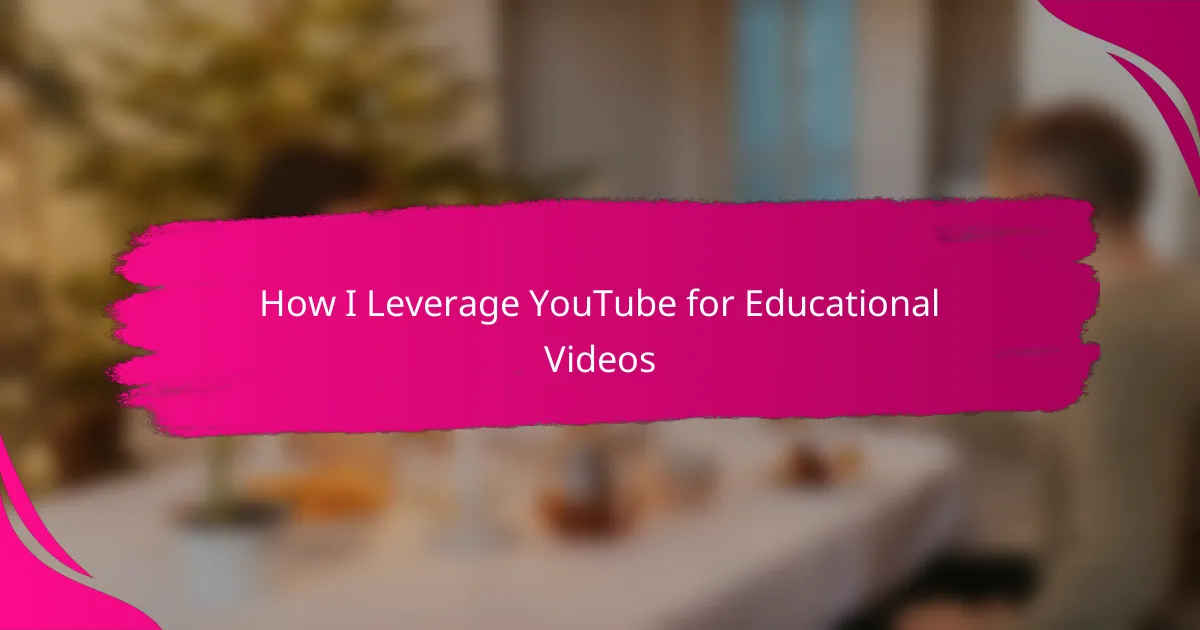Key takeaways
- YouTube educational videos effectively engage children by breaking down complex topics and using visuals, sounds, and storytelling, enhancing their learning experience.
- Parents can access a variety of parenting advice on YouTube, allowing for flexible, on-demand learning that fits their schedules and addresses real-life challenges.
- Creating engaging content involves using vibrant visuals, storytelling, and bite-sized information to maintain children’s curiosity and retention.
- Measuring the impact of videos includes observing changes in parenting practices, conversations sparked by content, and feedback from other parents in online communities.
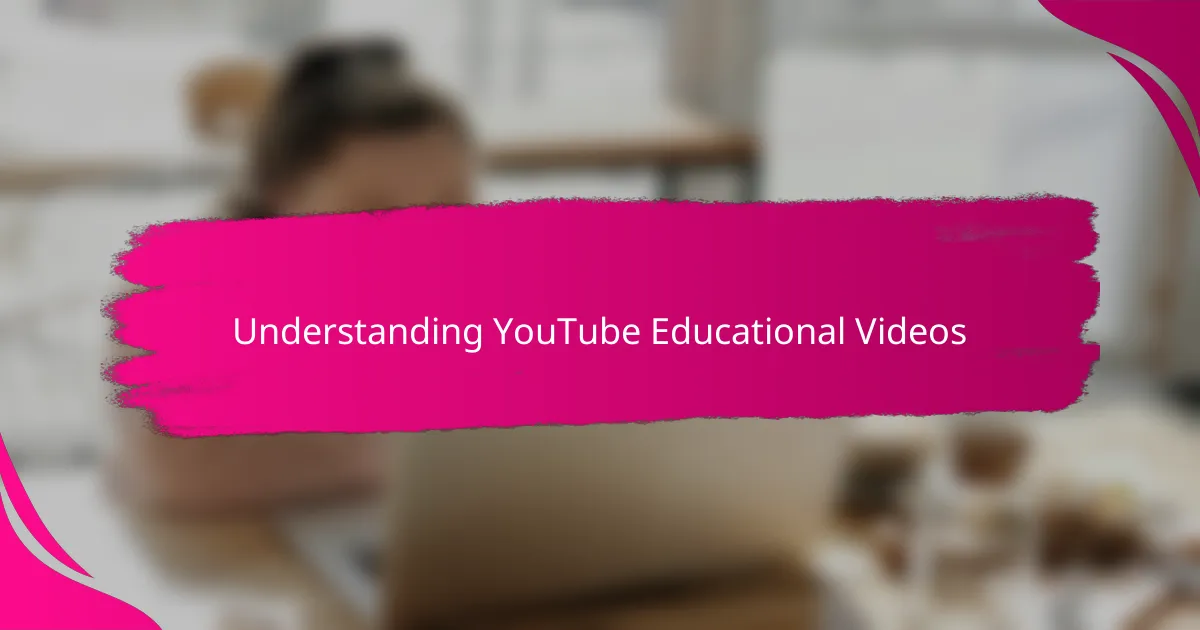
Understanding YouTube Educational Videos
YouTube educational videos have become a go-to resource for many parents like me who want to support their children’s learning at home. What strikes me most is their ability to break down complex topics into simple, engaging chunks—something traditional textbooks often miss. Have you ever noticed how a well-made video can capture your child’s attention in a way reading sometimes can’t?
From my experience, the variety on YouTube is staggering, covering everything from math tricks to science experiments and even art tutorials. This diversity means you can tailor your child’s learning to their interests and pace, which I believe makes a huge difference in how motivated they feel. Isn’t it amazing how accessible learning has become with just a few clicks?
What’s even more powerful is how these videos often combine visuals, sounds, and storytelling to create an immersive learning environment. I’ve seen firsthand how my own kids connect better when they see concepts come to life on the screen rather than just being told about them. It makes me wonder: how can we, as parents, harness this blend of education and entertainment without letting screen time get out of hand?
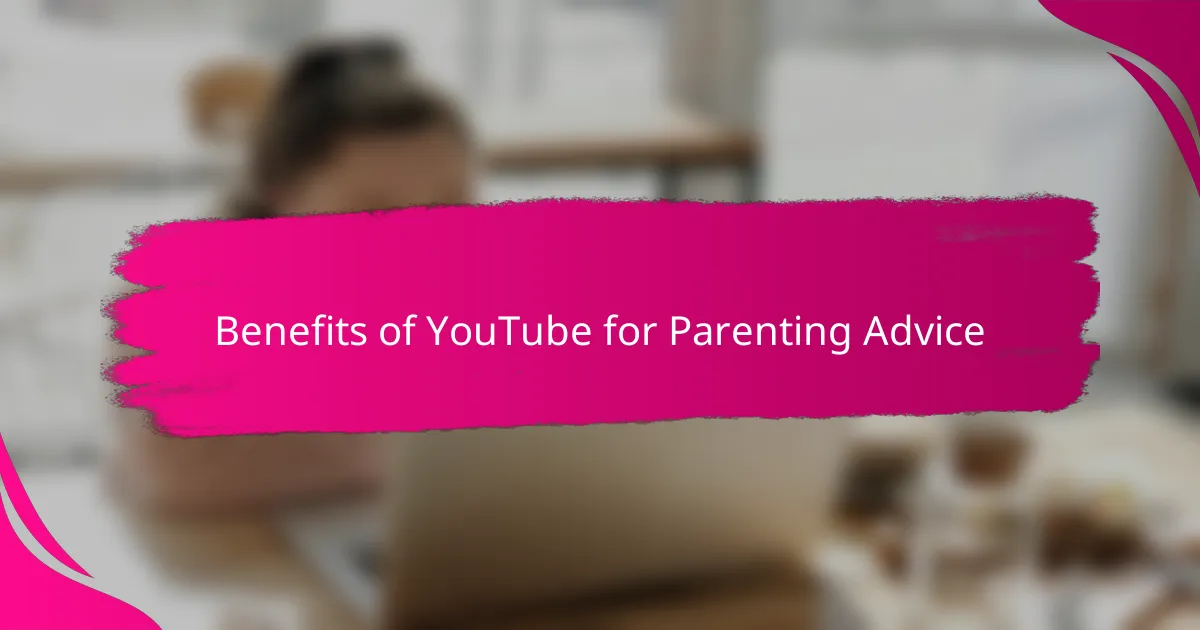
Benefits of YouTube for Parenting Advice
One of the biggest benefits I’ve found with YouTube for parenting advice is the instant access to a community of experts and fellow parents. Whenever I face a parenting challenge, I can quickly find videos offering practical tips and real-life stories that resonate with what I’m going through. Isn’t it reassuring to know you’re not alone and that others have walked the same path?
Another advantage is the flexibility YouTube offers. I can watch advice videos whenever it fits my schedule—whether during a quiet moment at night or while waiting for the kids’ activities to end. This kind of on-demand learning has helped me absorb information without feeling overwhelmed, which is crucial when parenting already feels so demanding.
What I appreciate most, though, is the variety of perspectives available. From gentle parenting techniques to strategies for managing screen time, I find that YouTube exposes me to ideas I might never have encountered otherwise. It’s like having a roundtable of insights at my fingertips, encouraging me to reflect on my own approach and try new things with confidence.
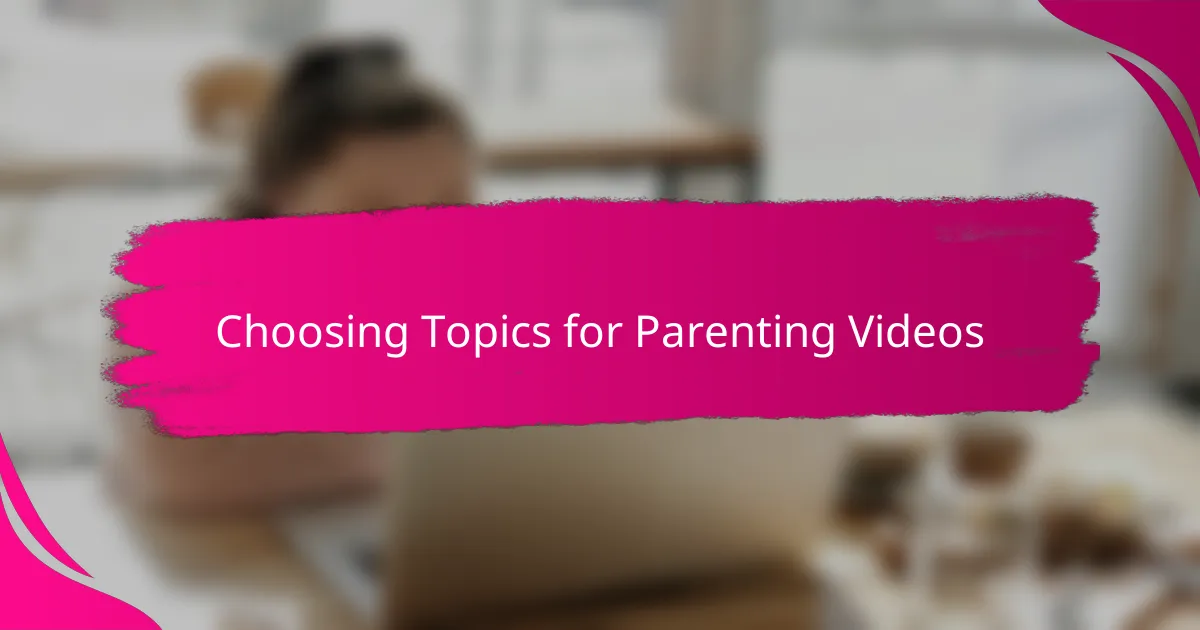
Choosing Topics for Parenting Videos
Choosing topics for parenting videos isn’t always straightforward. I usually start by reflecting on the challenges my own family faces—whether it’s sleepless nights or managing sibling rivalry—and then search for videos that speak directly to those issues. Have you ever noticed how relevant advice feels more comforting when it addresses what’s happening in your daily life?
Sometimes I pay attention to the questions my kids ask or the concerns friends bring up during playdates. These real-life moments often spark ideas for topics that other parents might find just as pressing. It’s fascinating to see how shared experiences can shape the themes I choose to explore on YouTube.
I also try to balance practical tips with broader ideas that encourage personal growth as a parent. For example, videos about fostering empathy or building resilience might not have immediate “fixes,” but they offer valuable tools for long-term development. Don’t you think parenting is as much about learning yourself as it is about teaching your children?
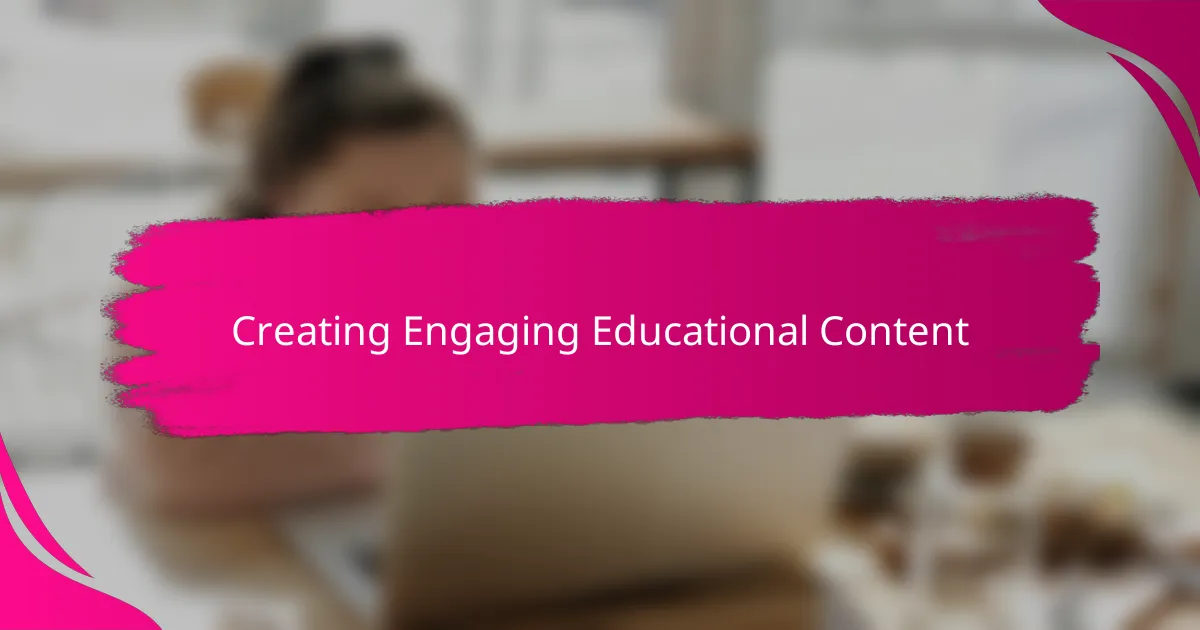
Creating Engaging Educational Content
When I create educational videos, my first focus is grabbing attention right from the start. I find that using vibrant visuals and relatable examples makes a huge difference. Have you ever noticed how a simple, colorful animation can turn a dull topic into something your child actually wants to watch?
Storytelling is another tool I lean on heavily. Instead of just listing facts, I try to weave them into a small story or real-life scenario—this way, the information feels meaningful rather than abstract. It reminds me of how my youngest lit up when a science concept was explained through a fun experiment we could try together at home.
I also pay close attention to pacing and clarity, breaking content into bite-sized pieces to avoid overwhelming young viewers. From experience, short segments with quick recaps help kids retain information better and keep their curiosity alive throughout the video. Isn’t keeping them curious the ultimate win in educational content?
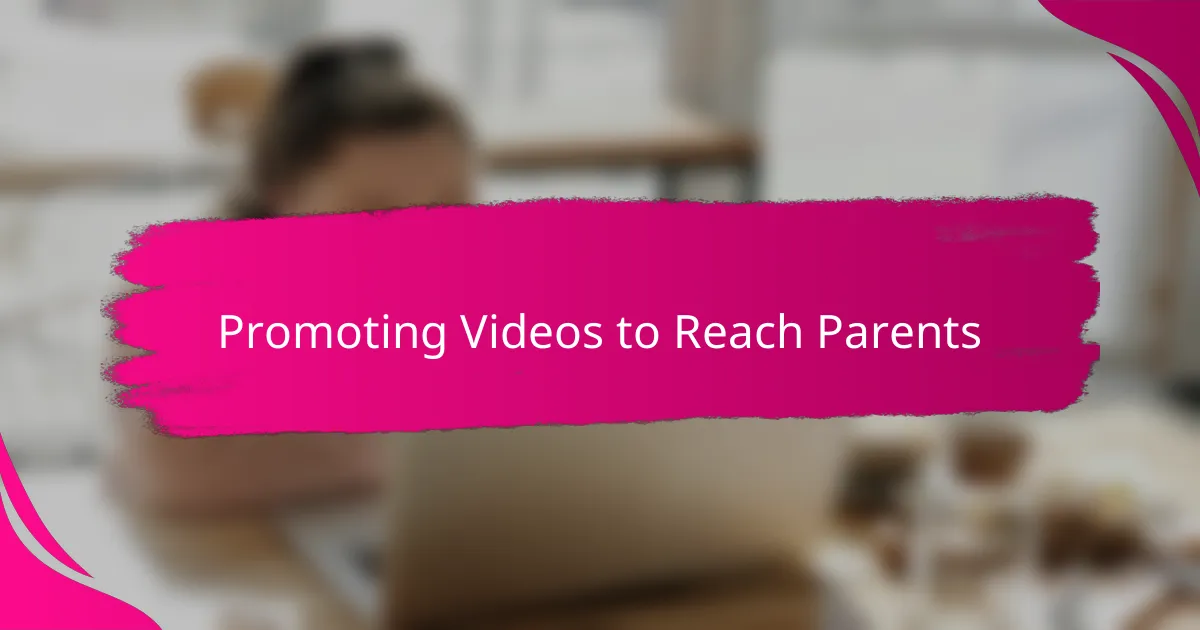
Promoting Videos to Reach Parents
Promoting videos to reach other parents means more than just uploading content and hoping for the best. I’ve learned that sharing videos in parenting groups and communities where like-minded moms and dads gather can make all the difference. Have you ever felt the surprise when a simple post sparks meaningful conversations and connections?
I also try to harness the power of social media beyond YouTube itself. Posting snippets or behind-the-scenes moments on platforms like Facebook or Instagram not only boosts visibility but also creates a more personal link with parents who might benefit from the full videos. It’s a subtle way to say, “Hey, I’m here sharing this because it helped me, too.”
Another trick that’s worked well for me is engaging directly with viewers through comments. Responding promptly and encouraging questions turns the video into a dialogue rather than a one-way broadcast. Don’t you find that sense of community often makes parenting feel a little less isolating?
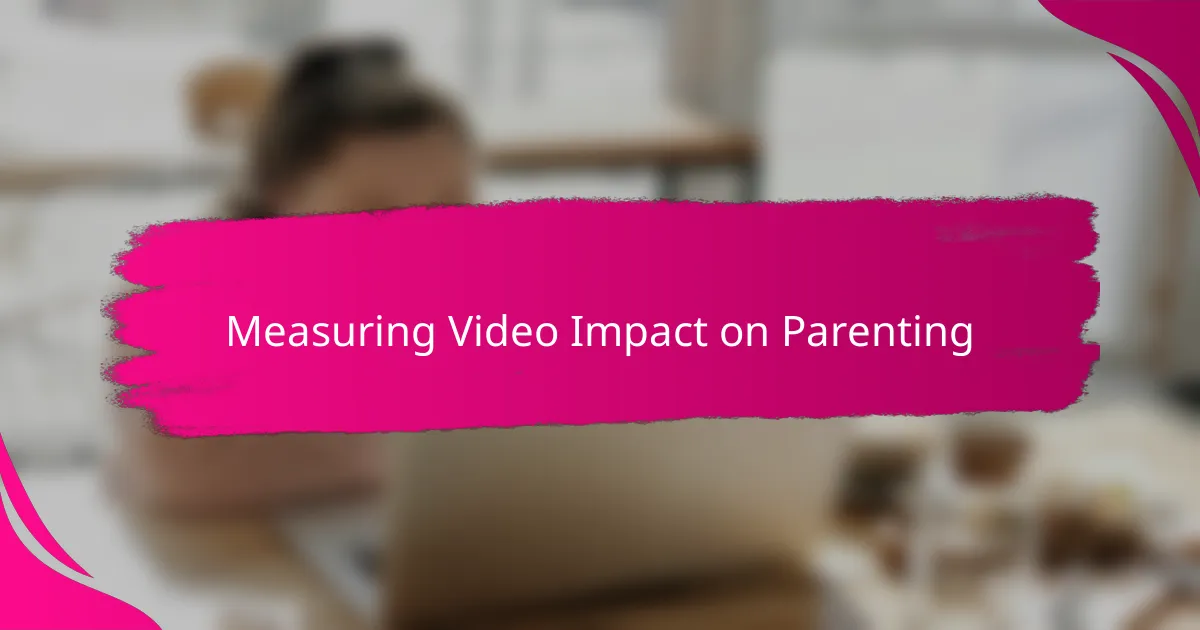
Measuring Video Impact on Parenting
Measuring the impact of educational videos on my parenting has always felt a bit tricky, but one thing I’ve noticed is how certain ideas from videos actually translate into our daily routines. For example, after watching a video on managing toddler tantrums, I found myself more patient and using the suggested calming techniques, which genuinely changed how we handled stressful moments. Have you ever experienced that subtle shift where something you learned online starts to become a natural part of your parenting style?
I also pay attention to the conversations my kids have afterward. When they start asking questions or showing curiosity sparked by a video, it tells me the content really resonated beyond just being passive screen time. In those moments, I realize the video has done more than just entertain—it has actually sparked learning and growth.
Lastly, I keep track of feedback from other parents who’ve watched the same videos, especially in online groups. Their comments and shared experiences often help me gauge whether the advice truly makes a difference or if it needs tweaking. Isn’t it reassuring to know that this collective wisdom helps us all become better parents?
